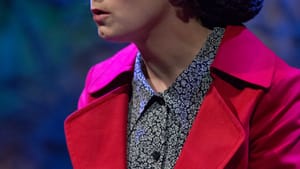Stay in the Loop
BSR publishes on a weekly schedule, with an email newsletter every Wednesday and Thursday morning. There’s no paywall, and subscribing is always free.
A troubling sight
Lantern Theater Company presents Brian Friel’s ‘Molly Sweeney’

Words wash over the viewer of Molly Sweeney, Brian Friel’s affecting exploration of loss by acquisition, now available as a streaming production from Lantern Theater Company. Often compared to both Shakespeare and Chekhov, Friel (1929-2015) supplies drama as much through steady streams of poetic language, unafraid to be verbose or hyperbolic, as with any specific situations his character might find themselves in.
The three individuals who populate this elliptical play, which dates from 1994, never actually speak to each other, despite sharing intimate bonds. Instead, they speak directly to us—and in doing so, they reveal the innermost depths of their souls, in ways that they might not communicate, even to a loved one. As in Friel’s similarly structured masterpiece Faith Healer, which London’s Old Vic produced for a worldwide streaming audience back in September, spectators sense they are eavesdropping on thoughts and emotions that might typically be held close to the chest.
A decision and its aftermath
Based loosely on a case study by the late neurologist Oliver Sacks, Friel considers a woman (Geneviève Perrier), blind since infancy, who, now in her early forties, is offered the chance to partially regain her vision through a risky operation. Her somewhat new husband, Frank (Ian Merrill Peakes), supports the procedure, which would be performed by Mr. Rice (Anthony Lawton), a once-promising eye surgeon brought low after years of depression and alcohol dependency.
Molly considers the weight of this decision in the play’s first act; in the second, she and her companions deal with the aftermath. Refreshingly—especially for a play written before the current broadening awareness toward ableism and disability rights—Friel avoids presenting Molly’s becoming sighted through the lens of a miraculous conversion. In fact, he makes her, and those around her, keenly conscious of what she must sacrifice in order become sighted. We first meet Molly as a confident and self-sufficient woman, in no way encumbered by her lack of vision. After her operation, she must contend with a world that suddenly feels unfamiliar and often menacing.
Friel also examines the ways in which Molly’s husband and doctor use her for their own ends. Frank Sweeney comes across as a small-time hustler, a layabout looking for a get-rich-quick scheme, and a man willing to turn his wife’s recovery into his own success story. Mr. Rice, though sympathetic at times, is also not above using Molly to usher in his own redemptive arc. In a sense, Molly becomes collateral damage to the expectations and ambitions of the men in her life—a woman not in need of saving who ends up “rescued” anyway.
Stillness and motion
Although Perrier doesn’t quite summon the raw energy that Kirsten Quinn brought to the role in Irish Heritage Theatre’s 2016 staging, she deftly communicates Molly’s tragic erosion of self. She taps into a riveting stillness that feels self-possessed before the operation, gradually becoming a reflection of Molly’s rootlessness as she joins the sighted world. Perrier has long had one of the most expressive faces in Philadelphia theater, and her ability to shift from levity to devastation through just a subtle tilt of the head or flick of her eyes is captured well by the camera.
Peakes delivers an intensely frenetic performance—his arms and legs always in motion, even when seated—that gives physical credence to Mr. Rice’s observation that he possesses “the indiscriminate enthusiasm of the self-taught.” There’s more than a touch of the mountebank in his conception of the character, but Peakes also conveys a genuine belief that Frank is helping his wife by pushing her toward the world of the sighted. Lawton communicates the twinned senses of arrogance and self-pity that permeate Mr. Rice’s countenance. Like many Friel plays, Molly Sweeney takes place in the fictional Irish county of Ballybeg; all three actors manage convincing accents, including a slightly posh inflection for the anglicized Mr. Rice.
Elemental storytelling
The production was filmed on the stage of St. Stephen’s Theater, Lantern’s usual home base, and it makes better use of the oddly constructed playing area than the past several in-person productions I saw there. Nick Embree’s set suggests a dreamlike, suspended world in which the characters can look back on their experiences from a slight remove. The lovely, soft-grained lighting by Janet Embree further implies the surreal. Peter DeLaurier’s direction seems subtle on the surface, but I came to appreciate how he established different rhythms for each actor, emphasizing the lingering unreliability of three people telling the same shared history from disparate perspectives.
Despite the lack of interaction between the principals, Molly Sweeney never suffers from a lack of drama. Perhaps that’s because so much of Irish theater, from Shaw to O’Casey to McPherson, boils down to storytelling at its most elemental. DeLaurier and his company understand that, and in turn, they deliver an experience both simple and striking.
Image description: Actor Geneviève Perrier in the Lantern’s filmed production of Molly Sweeney. In a close-up, Perrier is seen in a three-quarters view, with a calm, attentive expression. She has brown hair pulled in a blue snood, and wears a floral-patterned shirt and a red coat with large lapels.
What, When, Where
Molly Sweeney. By Brian Friel. Directed by Peter DeLaurier. Lantern Theater Company. Available to stream through March 7, 2021 ($20 per household rental fee). Tickets and information available at lanterntheater.org.
Molly Sweeney is closed-captioned.
Sign up for our newsletter
All of the week's new articles, all in one place. Sign up for the free weekly BSR newsletters, and don't miss a conversation.
 Cameron Kelsall
Cameron Kelsall